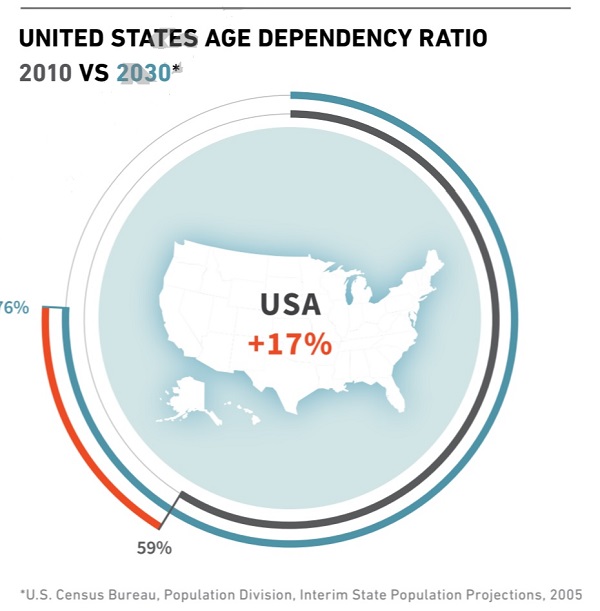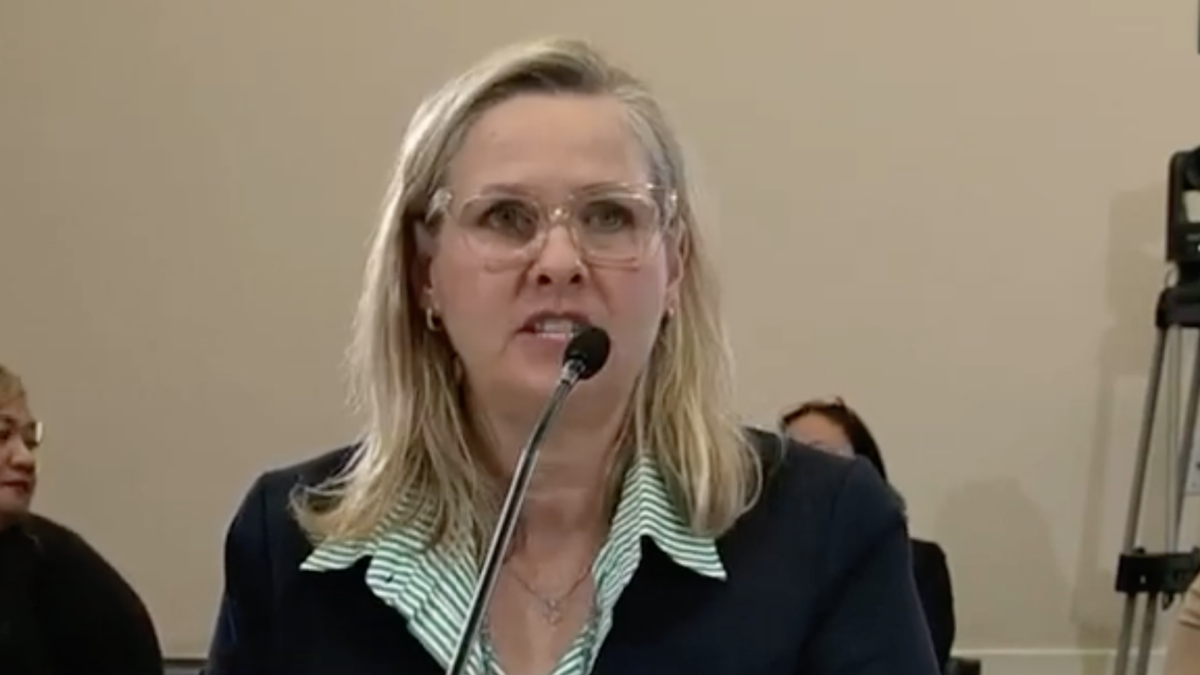
President Obama’s most recent budget makes it clear, the Wall Street Journal says, that while Republicans need his signature “to arrest America’s coming fiscal crackup,” they’re “unlikely to get even the back of his hand.”
Nobody, least of all the addict, likes to address an addiction. But, at some point, adults have to walk into the room and take charge. One hopes they don’t wait to do so until the addict’s self-destruction is complete. But the window of opportunity for an effective intervention on this country’s behalf is closing, rapidly. The next presidential election may be it.
A sobering new report points out yet one more factor accelerating that window’s downward fall. It considers the ratio of people who eat tax dollars while generating little to no tax revenue against the people who generate the tax revenue that pays for the others. You might think it’s a comparison of welfare cases, but it actually measures the dependency ratio with the very young and elderly on one side and people of working age on the other. Children consume public resources (primarily through school, but also a huge proportion of them receive government healthcare) without, obviously, creating any; and through Social Security and Medicare, so do retirees. And this country will presently see a boom in children at the same time it sees a boom in old people, thus sharply increasing draws on public coffers. “Multiple states are projected to have one in four or more residents who are elderly [65 years or older],” the Foundation for Excellence in Education-Friedman Foundation report says. Elsewhere: “In 2030, the Census Bureau projects the cart to carry 76 people for every 100 pushing it.”
In other words, old people and children will face off in a competition for scarce public resources, while the middle-aged folks in the middle will be tapped to pay for everything (as the economy they have to do it in slows by half, projections say, thanks to the weight of federal debt and spending) while also raising their kids and figuring how to care for their aging parents. Gee, I’m so happy to be in that middle generation. Mom, dad, forget what I said about not sticking you in a nursing home.
My guess is the kids lose. There are fewer of them, they can’t vote, and so far Baby Boomers have been perfectly willing to screw future generations to meet their present desires.
Actually, though, the message of the report—and the important thing for people to believe and act on before it really is too late—is that there are things we and our representatives can and must do right now to avoid this trainwreck. Yes, these are huge challenges. But we’re America. Cheesy-sounding or not, we’ve taken on the big dogs and won before. We can do it again. Here are some ideas for how.
1. Make Taxpayers Pay for a Lot Less
The response to essentially every new idea that would add another blood draw to taxpayers already on life support should be: “We can’t afford it.” Because we can’t. We’re beyond flat broke. Government-backed preschool, daycare, college, younameit just has to be a total nonstarter even if these were justifiable reasons for a person to stick his hand in his neighbor’s wallet. If Congress wants to persist living in fantasy money-tree land, they should have their in-district residences handed back to them on silver platters and new people sent to Washington with an explicit mandate to bail like there’s no tomorrow.
President Reagan had it half right: People need lower taxes. It’s our money, and we spend it better than Washington. But we’ve since learned you can’t starve the beast. He’ll get his even if he has to maraud international banks for it. A “grand deal” means cutting taxes and spending, commensurately—and preferably more of the latter. The alternative is letting these absurd spending commitments overwhelm us, admitting that we’re already a European-style welfare state, and ending the American aspiration that each generation will live better than the last.
2. Accelerate Private-School Choice Programs
The report has this one right: “first generation private choice programs represent weak tea when contrasted against our present and future needs.” In other words, even though the Wall Street Journal declared 2013 the Year of School Choice and Republican governors everywhere are accessorizing themselves with voucher proposals, the programs they both propose and sign are, well, chintzy. They’re still accessories, and not even classy ones.
Take Indiana’s program, the largest in the nation. Only a third of the private schools in the state will participate, it has so many burdensome regulations more designed to turn private schools into public schools than achieve anything of value. Just two in five Indiana families can get vouchers, because there are strict income requirements. Nationwide, there are nearly 50 million school-age Americans; 2.3 million attend charters, and 343,000 enjoy private-school choice using vouchers or a version of vouchers. That means 0.7 percent of American kids participate in private-school choice. It’s not for lack of interest—it’s for lack of access. Two in five American parents, a plurality, say they would send their kids to private school if they could afford it. But most can’t, so more than four in five American kids attends public school.
So let’s put this into context. School voucher programs and other incarnations (including my favorite, education savings accounts, where parents get the control the entire voucher amount and divide it among education expenses, with the option to save leftovers for college) are a crucial opportunity to reduce the government-spending squabble between old and young by providing young people better education at about half the cost. Every high-quality (meaning randomized, controlled trial) study on private-school choice finds it increases student performance, both for the students who leave a given school and for the students who remain. There is really nothing to lose, except a lot of government bloat and coercion of parents and kids. This is a win-win-win situation, and in a world where options are about to get very constrained, we need as many of these as we can get. State lawmakers need to bust the doors on school choice, and stop piddling around congratulating themselves for helping less than 1 percent of their state’s kids achieve more at less cost to taxpayers.
3. Put Old-Age Entitlements On a Major Diet
Baby Boomers need to hear the truth: Their political demands have put their children on a no-hope-of-retirement treadmill and their grandkids on a starvation diet. Nobody likes to tell Boomers the truth, because they vote, but it must be done or their selfishness will lock the next generation into serious pain.
One major reset that needs to happen, both within government and socially, is to lift the expected retirement age, at least as it concerns when tax benefits will start kicking in. Many government pensions, for example, kick in full benefits at age 55. That’s gotta stop. But even 65 is unreasonable in an era when the average person at that age will live another 20 years. As everyone knows, Social Security used to kick in a year or two before the average age of death. Now it’s 20 years before death, subsidized by younger people for whom government will hardly be able to subsidize any retirement benefits. Ridiculous. Besides, who wants to sit around on golf courses for 20 years? That bores the heck out of even my family and older friends who enjoy golf.
Taxpayers have been asked to simultaneously extend their payments for non-working people at the end of life while expanding subsidies to non-working people at the beginning of life, through taxpayer-sponsored daycare and preschool all the way through six desultory years of college (bachelor’s degree not assured). And it’s not like we’re accelerating the workforce with all this money. The economy is slowing and sputtering as we pour more money into “preparing” for rather than participating in it.
Now, we would all love to live luxuriously and charge the next generation’s credit cards, but as Margaret Thatcher said, at some point you run out of other people’s money. That point is nearing. Taxpayers cannot afford to subsidize idleness. We have got to have more people pushing the cart, and fewer inside. No exceptions for Boomers, the richest generation in history.
4. Encourage Inter-Generational Relationships
One significant way Boomers can give back to society without government mandates is to invest their time and cash dollars into the generation that’s going to support them in old age, either directly through putting mom or dad in the guest room permanently or indirectly through paying their many government-sponsored medical bills. Here’s some ideas from a millennial with boomer parents about what I love them to do for me: Take as much of the load off parenting as possible. My parents and in-laws buy our kids clothes and toys, which for me kills two birds with one stone: No horrible series of shopping trips to procure the same, plus I don’t have to dig into my own pockets again. My mom even asks me, “What do the kids need now? Snow pants? Any baby gear?” Because shopping is not just a one-off for people on a budget. I potentially have to spend months looking for right-priced rain boots. My mom can run in and out of all the shops in town in one afternoon looking for a deal, and she likes doing it. Serious win.
My parents also were prudent and generous enough to have saved money that helped me get through college without debt. Now, there’s a super way to start off life for those who can foster it: Owing nothing but love to anyone. I can’t tell you how liberating that feels. Similarly able grandparents could pitch in for private-school tuition, which has the dual benefit of allowing their family to live in a community without stretching finances beyond breaking to pay the exclusive-public-school mortgage premium and jump-starting the grandkids in life with an objectively better education that can also support a family’s religious teachings.
Friends whose parents live closer luxuriate in their ability to put the kids with grandma so the at-home spouse can pick up a part-time job, or let frazzled parents pay some needed attention to their marriages with a casual date night. Lots of my boomer-generation aunts and uncles are recent empty-nesters, and spend their newly-freed time lifting for the second and third generation after them. We really appreciate it. It can make the difference between a hopeless, exhausted young family and one that can just make it through those little-kid years intact.
Those of you who don’t have family nearby should adopt a family. Believe me, we kids who live far from blood relations would appreciate that, too. Don’t stop there, folks. Reach outside your family to build your neighborhood’s social capital. Relationships are a far better social safety net than money. The more we do for each other voluntarily, the less we will use government to force from each other. Here are 150 simple ways to do it.
5. Restore a Content-Heavy Curriculum
This one is a favorite hobby horse of mine precisely because it is so powerful yet so overlooked. A major casualty of the culture wars and its resulting relativism has been the loss to American children of a systematic, conscious hand-off of their heritage. Those of us who have been granted some of this access to our cultural history will recall that in ancient days, when “every man did what was right in his own eyes,” it meant chaos. And chaos serves no one well but bullies. The weak are the ultimate losers, and children are always weak.
As with the insistence that “multiple definitions of family” work out just fine for the kids, so insistence that kids need to learn nebulous things like “collaboration” and “critical thinking,” that they don’t need “rote memorization of dry facts” but “to learn how to learn through open-ended problems,” harms kids. You will recognize these as the mantras of every teacher or curriculum specialist ever interviewed by any reporter nowadays. Taking no position on what, exactly, kids should learn serves adults who need widespread approbation to maintain their power, but it ends up depriving children of what society owes them: A good education that prepares them to contribute. And research resoundingly demonstrates that a content-haphazard education will leave a child poorly equipped both to think and engage in his culture. As E.D. Hirsch, the apostle of these insights, writes, “Verbal skill is known to be a chief constituent of adult success and effectiveness. But verbal ability is not, as the schools wrongly assumed, simply a how-to skill. It is largely a knowledge-based skill.”
A related point the report makes is that the majority of kids who do make it through America’s public education system are not well prepared to shoulder the heightened financial burdens already awaiting them upon graduation: “Discussion over income inequality should focus on the fact that 64 percent of American students fail to read proficiently after 13 years in one of the most expensive school systems in the world.”
Despite the insistence of some Common Core proponents, this national curriculum lockbox has not restored the emphasis on core and common knowledge that American kids need to, well, read. This is not just because the mandates specify little content, but because it’s impossible to set one curriculum ring to rule them all without some rebellion, unless that ring is itself inoffensive to the majority of educrats, who are doing it wrong. In other words, monopolies destroy product quality. And America’s education system is nothing if not an interlocking system of monopolies: Monopolies on attendance, teacher training, teacher hiring, testing, funding, and so forth. Monopolies will ultimately be controlled by those in power, as public schools are; and as anti-Common Core moms and dads are finding, the education power brokers are so wedded to anti-knowledge philosophy that given the chance they will replace Common Core with similar crap.
This brings us full circle back to school choice. People need the freedom to choose something better, which isn’t hard. But for most Americans, that door is closed. Choice is not a panacea, and politicians are selling a lot of snake oil using the choice label. But choice is a precondition for fixing a lot of other things. And American kids, America’s future, need all the help they can get. We’re in an all-hands-on-deck situation. It’s time for elected officials to stop being politicians and start being statesmen—and for their constituents to demand such behavior.










